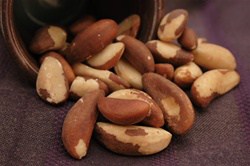A clementine is a hesperidium, of a variety of mandarin orange (Citrus reticulata) so named in 1902. The exterior is a deep orange colour with a smooth, glossy appearance. Clementines separate easily into seven to fourteen moderately-juicy segments. They are very easy to peel, like a tangerine, but are almost always seedless. Clementines are, thus, also known as seedless tangerines. They are typically juicy and sweet, with less acid than oranges. Their oils, like other citrus fruits, contain mostly limonene as well as myrcene, linalool, α-pinene and many complex aromatics.
The traditional story is that it was “originally an accidental hybrid said to have been discovered by Father Clément Rodier in the garden of his orphanage in Misserghin, Algeria.” However, there are claims it originated in China much earlier. James Saunt has commented that “Some authorities believe it is virtually identical to the variety known as the Canton mandarin widely grown in Guangxi and Guangdong Provinces in China.”
The Clementine is not always distinguished from other varieties of mandarin oranges. However, it should not be confused with similar fruit such as the satsuma, which is another name for the Japanese mikan, honey sweet orange, and is another popular variety. The clementine is occasionally referred to as Algerian tangerine.
This variety was introduced into California commercial agriculture in 1914, though it was grown at the Citrus Research Center at theUniversity of California, Riverside as early as 1909. Clementines, usually grown in Morocco, Spain and south of Bosnia and Herzegovina, have been available in Europe for many years. A market for them in the United States was created recently, when the harsh 1997 winter in Florida devastated domestic orange production, increasing prices and decreasing availability. California clementines are available from mid-November through January; this availability has them referred to in some areas as “Christmas Oranges”. Clementines are typically shipped in small wooden or cardboard boxes with a move in recent years to net bags.
Clementines lose their desirable seedless characteristic when they are cross-pollinated with other fruit. To prevent this, in 2006 growers such as Paramount Citrus in California threatened to sue local beekeepers to keep bees away from their crops.
As well being tasty trimmings to things like salads or cakes, clementines are worth their weight in gold around the house. From cleaning limestone countertops to keeping flies away to even maintenance stray hairs in place, there is nearly no limit to whatClementine oranges can do. On top of that, they are a extraordinary deal during the winter months that they are in season.
Those countertops identify how hard they can be to clean. In fact, many people resort to using costly cleaners that are filled with potentially harmful chemicals.
Instead of such cleansing agents, homeowners preserve use clementines! When cut in half, lightly curved in in salt and then lightly scrubbed on the marble, the clementines competently and naturally remove stain from the surface.
Clementine oranges can level be used to keep vermin away. If cat owners find that their kitties are frequently chewing on their houseplants, they can stay the cats at bay by unevenness the leaves of the plants by means of the peels of clementines.
Health Benefits of Clementines and its uses:
- Clementines are a good source of vitamin C, potassium, thiamin, and niacin.
- They also contain fiber and are a good natural energy boost. Clementines have almost no fat, and an average clementine has only about 35 calories.
- They’re great for snacking, dessert or in fruit salads.
- Clementines also make a wonderful addition to almost any green salad, or in hearty salads with whole grains and beans. I’ve included five of Diana’s recipes below to get you started.
- So by weight of fruit, a clementine has about half the vitamin C of an orange, but it has more Beta carotene. In addition, xclementines are smaller than oranges so you get less toal vitamin C.

